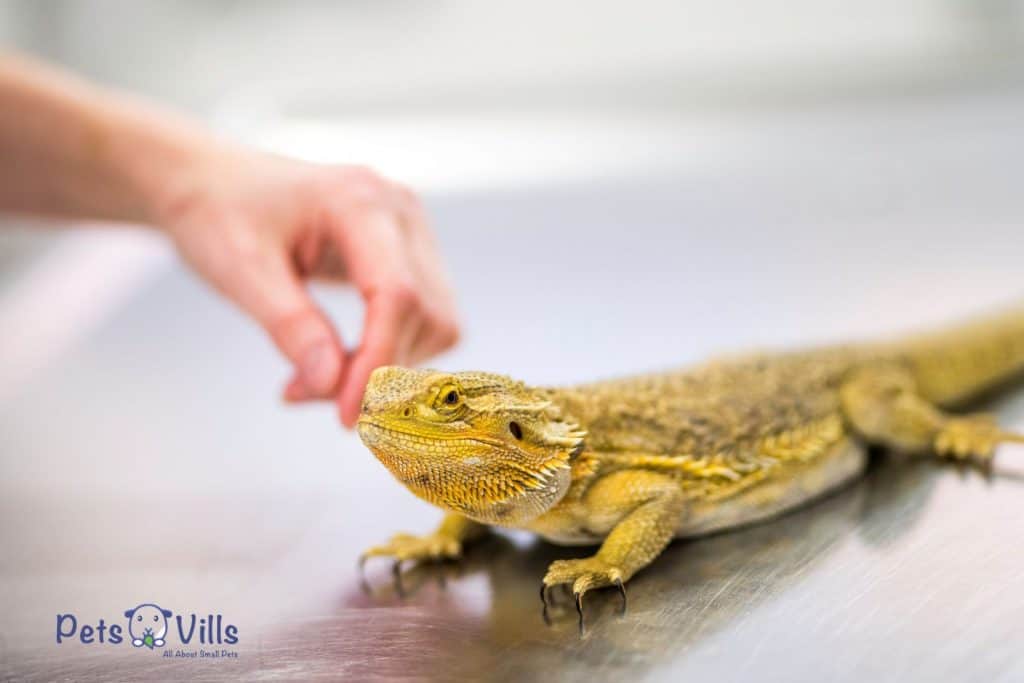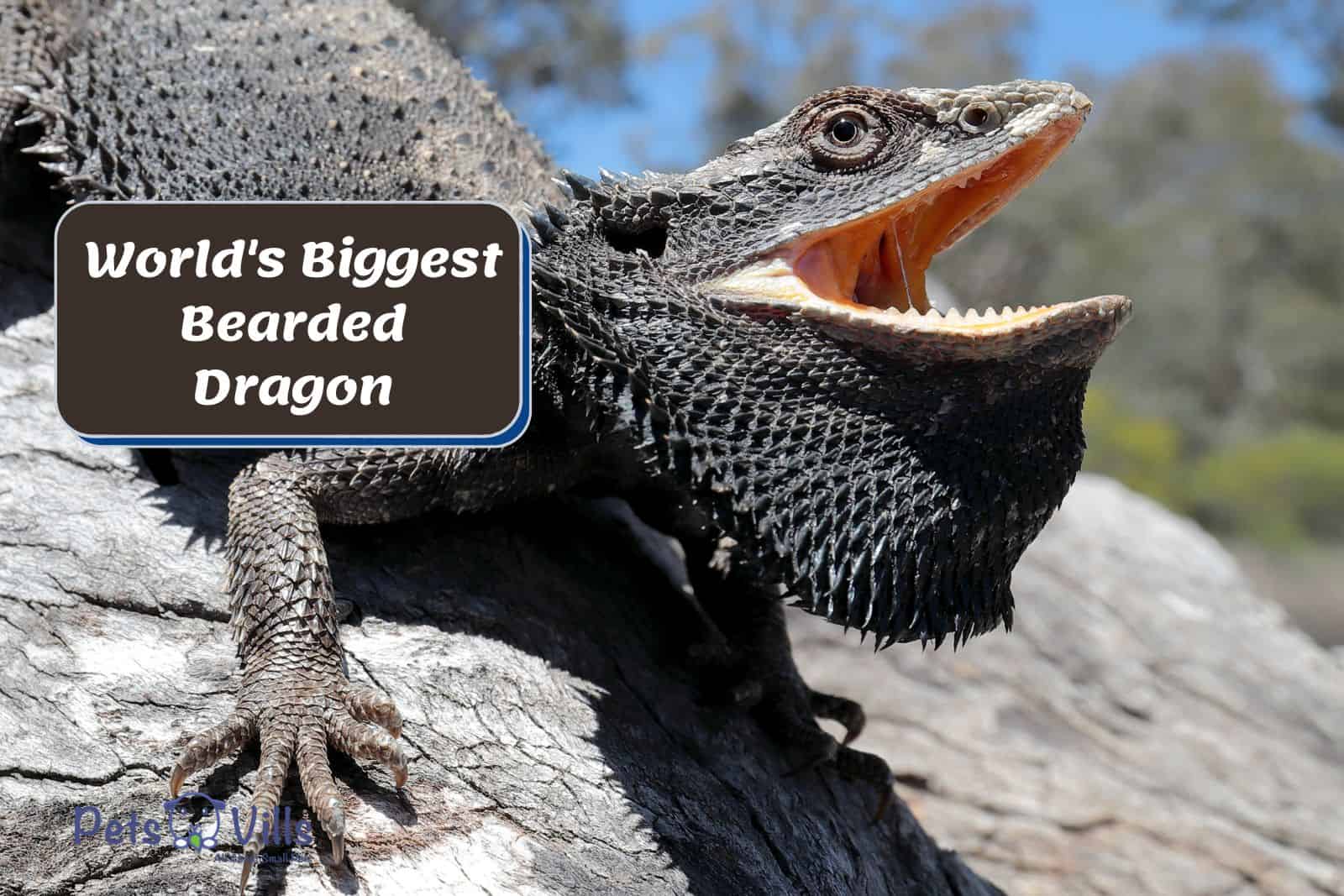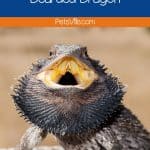It’s no secret I love my beardies; having had different bearded dragons for the past eight years, my love for the lizards knows no bounds.
My current favorite beardie Draco is a whopping 600 grams (he loves his food).
And this got me wondering, could Draco be the world’s biggest bearded dragon? Is it finally our turn to be in the Guinness book of world Records?
So I did my research, and here’s what I found about the largest beardies.
Also, check out the different kinds of bearded dragons.
Table of Contents
4 Largest Bearded Dragon Breeds
Bearded dragons are a popular pet, not just because of their unique appearance but also because they are hardy and easy to care for.
They come in a variety of colors and patterns. Here are the four largest breeds:
1. The German Giant Bearded Dragon
The German Giant Bearded Dragon is one of the most enormous bearded dragons sold in the United States. They can grow up to 30 inches long and have a lifespan of around ten years.
These large animals need a vast tank (at least a 100-gallon tank), so be prepared to invest in one if you’re keeping one of these guys.
The German Giant Bearded Dragon has a pink body with white spots on it, but they also come in many different colors. The lizard gets its name because it has an expandable flap underneath its throat.
The German Giant Bearded Dragon is an excellent choice for anyone who wants an animal that’s beautiful and easy to care for. [1]
They are low-maintenance and straightforward to care for but have specific unique requirements.
The best part is that they are a diurnal breed so you can have fun with your pet in your schedule.
A German Gaint’s diet should comprise 25% protein and 75% plant. Don’t forget to add calcium and vitamins to the diet. Some of the pets’ favorites are kale, broccoli, apples, yams, and collard greens.
2. The Central Bearded Dragon
They are also known as Inland Bearded Dragon or Western Bearded Dragon. Its scientific name is Pogona vitticeps. [2]
It has a low-lying body making it possible to lie completely flat on surfaces. It appears spiky due to its elongated spinous scales at the lower sides of the body. But the body is rubbery, and the appearance is to scare off predators.
The central beardie comes in a variety of colors. From red, black, fawn, brown, and yellow to camouflage its habitat.
With a weight of up to 510g and a length of 61 cm, the beardie has a life span of up to 15 years.
This beardie is an opportunistic omnivore with little feeding preferences. It has a huge stomach that can hold a lot of food. These dragons eat tiny rodents, lizards, insects, spiders, and even plants.
Also Read: Things To Know About Leatherback Bearded Dragon
3. The Eastern Bearded Dragon
Scientifically known as Pogona barbata, the Eastern beardie grows up to 60cm in overall length. [3] Its physical appearance consists of molted grey and yellow tones and pale blotches on its spine.
It has a rugged spiky appearance which is contrary to its calm disposition. It has a row of spines along its body and across its forearm.
With its triangular head, 24-inch snout tail, and throat covered in grey scales, it often performs its beardie display.
Its diet is majorly composed of 80-90% vegetable matter. Wild eastern beardies forage on roadside insects, worms, snails, small lizards, flowers, fruits, and other soft plant matter.
Eastern Bearded Dragons are semiarboreal to avoid danger or to get some sun. You’ll see them lazing on your fence or a tree in the backyard.
Take a look at this video.
4. Mitchell’s Bearded Dragon
The Mitchell’s Bearded Dragon is a pet known for its calm and gentle nature. The long-term health of this breed is excellent, and the life span is up to 10 years.
The body of this breed is sturdy and stocky, with a long tail that can measure up to 45cm. The Mitchell beardie comes in various colors, from red, yellows, and tans.
They are very rare beardies, and their natural habitat is deserts and semi-tropical woodlands.
Another interesting breed is the citrus bearded dragon.
Buy my productFactors that Affect The Size of A Bearded Dragon

The size of the Bearded Dragon is an essential factor to consider when considering which bearded dragon breed to purchase.
The size of the Bearded Dragon may vary from one species to another, but there are specific factors that affect the size. The size of a Bearded Dragon is affected by factors such as gender, age, and health.
1. Genetics
The genetics of a beardie will determine its final size and shape. As a result, there is no way for you to make your pet grow larger or smaller than it was born with.
2. Gender
The gender of a Bearded Dragon will affect its size. A male Bearded Dragon will be larger than a female because he has more testosterone in his body than does his female counterpart.
Testosterone is responsible for muscle growth and bone growth in men and women.
3. Age
The age of a Bearded Dragon will affect its overall size. A young or adult animal should be more significant than one still growing or developing because they have not yet reached its full potential.
A juvenile animal could grow into an adult-sized pet while its younger sibling will remain small throughout its life.
4. Diet & Environment
The diet and environment affect how big your bearded dragon grows. Suppose you feed your bearded dragon an insect diet and keep him in a terrarium with high humidity levels.
In that case, he will become more significant than if fed an insectivore diet and kept in a dry terrarium with low humidity levels.
5. Health
A healthy Bearded Dragon should also be more significant than an unhealthy one because it has more energy and resources available than a sick animal who may not be able to eat as much or perform as well as its healthy counterpart can do.
Conclusion
As you decide on the enormous bearded dragon for your family, please keep a few points in mind. Are you willing to handle and feed a large, adult-sized animal?
How much time can you devote to caring for it? Do you have enough space to allow the dragon to run around and explore?
Are there any children or pets in the home? How much space do you have available for your dragon’s cage? Your decision should be based on how well your entire family can handle such a commitment.

Resources
1. Introduction to Bearded Dragons by Naomi – Issuu [Internet]. issuu.com. Available from: https://issuu.com/naomi95/docs/introduction_page_1
2. Available from: https://www.researchgate.net/publication/329508118_Central_Bearded_Dragons_Pogona_vitticeps_The_UFAW_Companion_Animal_Handbook
3. Wotherspoon AD. Ecology and management of Eastern bearded dragon : Pogona barbata [Internet]. Westernsydney.edu.au. UWS Research Direct Website; 2022 [cited 2022 Sep 29]. Available from: https://researchdirect.westernsydney.edu.au/islandora/object/uws:2371/

Andreea is a very passionate content creator and her purpose is to provide you with the most interesting articles, while constantly discovering new facts. She’s been freelance writing for the past five years and has created numerous articles and educational materials while managing her own mom blog.
Read her Latest Articles
Find her on
FACEBOOK AND Instagram


